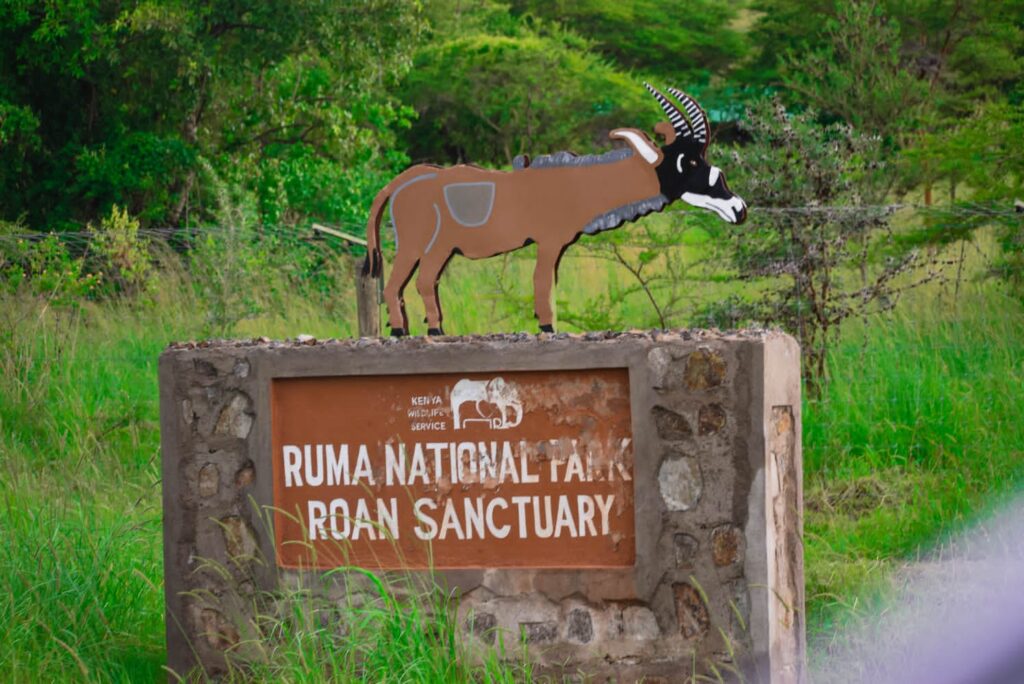In May 2023, Homa Bay County Government hosted a rare marathon; Roan Antelope Half Marathon.
The run dubbed “run with the roan” was organised in collaboration with the Kenya Wildlife Service and other stakeholders to promote the conservation of the rare roan antelope and market the park.
Governor Gladys Wanga announced that the marathon will be held annually, in what she termed as a step up in the conservation efforts to protect the rare roan antelope.
The antelope species is found in the Ruma Park only, and Wanga said their conservation would be a great boost to the county’s tourism sector.
“We hope to attract more visitors through such events,” she said.
hen I moved here in the year 1960s, there was no park. The animals used to roam around and we would hunt them at will
Mzee Adada
Homa Bay County lies at the shores of Lake Victoria, covering 60 per cent of the Kenyan shores of Lake Victoria.
The county boasts of notable tourism attraction sites which include; Simbi Nyaima, Tom Mboya Mausoleum, Kanjera Archeological Site, Homa Hills Hot Springs, Mawanga Rock Art, Takawiri Island, Gwasi Hills, among others.
However, Ruma National Park remains a key resource, being the only site hosting the rare Roan Antelope in the Kenya.
This park was established in 1966 to protect its indigenous population of rare Roan antelope which exist nowhere else in Kenya. It acquired national park status in 1993.
And for the first time, the initiative to save the rare antelope has roped in locals, the once missing link in the conservation of the animal.
The locals, mostly the Luo tribe, have haboured a culture that almost pushed the animal to extinction.

The destructive culture
Raphael Adada, 96, is a resident of Lambwe Valley, a few steps from the park. In his heydays, Adada practiced hunting at the park.
“When I moved here in the year 1960s, there was no park. The animals used to roam around and we would hunt them at will,” he reminisces.
He adds; “Our main meals were bush meat, fish and crops such as cassava and sorghum. Maize was still a foreign food those days.”
According to Adada, a young man would hunt for a Roan’s meat then present it as a gift to the woman he was interested in marrying.
if you could manage to kill Omoro and present it’s meat to your in-laws, then you were considered more of a hero by your in-laws. That’s why it was majorly hunted
Mzee Adada
By doing this, a suitor was regarded to be strong and fierce, a sign that he could offer protection to his wife to be.
This was so because Roan antelope was a fierce and aggressive animal which was not so easy to hunt as it would even kill.
“If you wanted to hunt Omoro (the local name for Roan Antelope), you must be near a large tree that you could climb to rescue yourself when it charges at you. Without that, you would be dead,” he says.
“So if you could manage to kill Omoro and present it’s meat to your in-laws, then you were considered more of a hero by your in-laws. That’s why it was majorly hunted,” he added.
Adada says that the male children who were strong and fierce were named after the animal; Omoro, because of their strength and fierceness.
Despite the park hosting other animals such as buffaloes, Adada says there was some form of prestige in hunting the roan antelope.
“The buffaloes provided us with meat and leather and the Roan’s meat was for marriage negotiations,” he says.
This assertions are shared by Homa Bay county Deputy Director at Kenya Wildlife Services Catherine Wambani, who says the cultural beliefs of the community around has contributed to the decline of the Roan antelope.
“The locals hold so dearly the meat of the Roan antelope. They use it for marriage negotiations and this has made them to continue hunting for this animal,” said Wambani.
“However we continue to create awareness and sensitize the community against hunting the Roan and support us in preserving the few ones remaining. That’s the main reason Roan Antelope Half Marathon was held,” she added.
And with the involvement of the locals in the conservation of the animal, Adada says there has been change of attitude, with the locals taking lead in protecting the park.

Dwindling numbers of Roan Antelope
According to records from KWS, currently there are only 25 Roan Antelopes in Kenya which are preserved in a Roan Sanctuary in Ruma National Park.
David Oyugi, the Warden in charge of the park says the alarming rate of extinction of the animal is what prompted stakeholders to take urgent steps to conserve them.
In 2021, the Roan Antelopes were moved to their own sanctuary after it was discovered they were prey to most predators like hyenas and leopards as well as human beings who continued to hunt on them especially due to cultural beliefs they held about the meat of the Roan.
With the sanctuary, there is close monitoring of the Roan in terms of their feeding and movement to enable multiplication
David Oyugi
During this intervention, there were only 12 roans in the park.
Apart from protecting the animals, the introduction of the sanctuary also provided proper environment for breeding.
In 2022, nine Roan Antelopes were brought into the sanctuary from Tanzania to enable cross breeding to enhance reproduction and multiplication.
“With the sanctuary, there is close monitoring of the Roan in terms of their feeding and movement to enable multiplication,” said Oyugi.
He noted that there has been a continued sensitization among the community around on the importance of preserving the Roan.
He says it was this initiative that birthed the half marathon organised in collaboration with the County Government, and which is set to be an annual event.
“The main objective of the marathon was to sensitize the community to forgo their culture of hunting the Roan for a bride prize and join hands in protecting and preserving it,” he said.

The Roan Antelop
The Roan Antelope, unlike other breed of antelopes, is brown in colour and bigger in size with long horns that curves inwards. The name roan originates fro its colour.
The roans feed on short and tender grass and drinks a lot of water. This informs why it can only survive in areas with short grass and swampy open ground.
The animal is fierce and more aggressive compared to other species of antelopes, and it has a lifespan of approximately 15 years.
But with the cultural challenge largely sorted, Wambani says another huge challenge is low reproduction and inbreeding among the Roans.
“We only had one adult male Roan antelope with the rest being females and young males that cannot reproduce. With only one male adult, the reproduction has been difficult and slow. This also explains their low numbers,” said Wambani
“Inbreeding has also resulted to reproduction of weak offsprings. This has posed a challenge in their growth and survival,” she furthered.
She however noted that this challenge will be sorted with the introduction of nine roans from Tanzania.
Wambani says this is an ongoing process as they are planning to bring more species from Tanzania to enable them to increase the number of Roans in the park and possibly distribute them to other parks in the country with the same habitat.
She also adds that they are conducting experiments and research to determine what could be making the Roan to reduce in number and have low reproduction other than the factors mentioned above.
These steps she believe, will enable them to improve and be able to increase the number of Roans not only in Ruma National Park but in the country as a whole.
